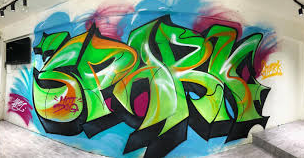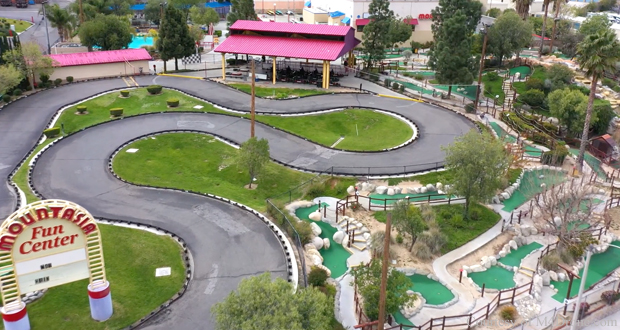
Introduction to Graffiti:
Graffiti is a type of modern art in today’s world. This art form is unique regarding the experience, the people, and the art form itself. The art that gets put up on the wall usually consists of writing a word in an abstract style to catch the eye of a person. The official definition of graffiti is: “writing or drawings scribbled, scratched, or sprayed illicitly on a wall

or, other surface in a public place.” Google supports that graffiti is a form of illicit vandalism. Though, the main focus of graffiti is to make one’s name be heard across the city and be almost like an underground “celebrity.” But, some who partake in graffiti die doing it for the sole purpose of “liking [to do] it” which is the usual thing that is said when they are being interviewed. But there is a high suspicion that they might have some sort of “addiction” to the art form. Most serious graffiti artists do it to express themselves because they usually come from an unchancy upbringing. They also do it because they want to risk their lives for the adrenaline feeling of doing something wrong. But,

there are a small number of people that “just do it.” Graffiti is done all over the world with many styles and many ways of participating in it. Graffiti is an illegal practice and is considered vandalism. Numerous people hate graffiti artists or anything to do with the art form. Many graffiti artists go out of their way to vandalize private properties that people own. Graffiti artists cause a lot of money loss to the owners of the private properties by needing to paint over objects and replacing walls that have been vandalized. People despise not just the practice but the look of the art itself. However, other people do appreciate the art that is put up and even take pictures to share with other people and maybe even publish online. They like the art but they usually don’t endorse it to other people because they only enjoy the art that is already put up and appreciate it like a painting. Most people either love or hate graffiti. Graffiti has a long history from its start to its explosion in popularity, and how it’s doing now. Graffiti has evolved for many generations.
Recorded Origin of Graffiti, “Cornbread”:

There are many sayings on how graffiti got started but one of the most notable graffiti writers goes by the name of “Cornbread” in Philadelphia, Pennsylvania, in the year 1965. His actual name is Darryl McCray and he is known as the graffiti legend or the “father” of graffiti. At only 12 years old, Darryl started “tagging,” or writing on the walls due to a crush on a girl he had. The girl’s name was Cynthia Custuss and her name was usually tagged along with the name of “Cornbread,” and typically went like: “Cornbread loves Cynthia.” Of this occurrence, the first form of graffiti was created, tagging. Darryl McCray is still alive today, retiring from graffiti in 1971 with one final tag that said, “Cornbread has retired.” Today, Darryl is a public speaker and a youth advocate who speaks out about not doing drugs and abiding by the abiding the law. He is currently married to a good friend, Consuela Sanchez. Tagging is known today as the easiest way to put one’s name up on the wall and the easiest to master. Some tags are considered ugly while others do look visually pleasing to the eye.
Graffiti’s Explosion in Popularity, “TAKI 183”:
There was another famous graffiti artist that enjoyed tagging the city that earned the name “The Forefather of Graffiti.” His tag name was “TAKI 183” and he was one of the most known graffiti writers in New York in 1971. He influenced many in New York to participate in graffiti and caused a large commotion in the city. Even though he is one of the most prominent graffiti artists, his origin is nothing like a superhero. In 1971, graffiti was a popular subject in New York due to Cornbread. But in popularity, TAKI 183 was prominent with his tags stretching throughout Manhattan. People wanted to know about TAKI 183, due to his “dedication” in getting his name across the city. Many people disliked him due to the uprising he caused. Then, The New York Times did an article on him, having

the headline of, “‘TAKI 183’ Spawns Pen Pals.” It turns out, TAKI 183 was a bored 17 year old kid. Demetrius, TAKI 183’s real name, wanted to try graffiti due to him being bored in the summer of 1969 and seeing a tag of “JULIO 204” which he “took the form of.” The name TAKI 183 was created from “a traditional Greek diminutive for Demetrius” and the number was from his street number, 183. In the span of 2 years, Demetrius went from simply tagging on ice cream trucks to rumored to be tagging “a Secret Service vehicle and the Statue of Liberty.” The job he had as a delivery boy, made it easier to access locations all over the city. When The New York Times questioned him on how he feels about the costs of 80,000 hours and 300,000 dollars of repairs, he said he is just a normal guy and that companies “shouldn’t target the little guy and go for campaigns or organizations that put up numerous stickers in the subways.” Today Demetrius is

retired and doesn’t not participate in graffiti anymore. It is documented that he went to college while still doing graffiti. He studied car repair and bodywork and after many years of graffiti, he has started a family. Currently, Demetruis is not relevant in the graffiti community, other than the history he left behind. Demetrius is living a happy life with his family that has not been documented. With TAKI 183’s explosion in graffiti, many people started to participate in it, creating many different styles. These styles consist of: throw ups, wildstyle, calligraphy, blockbuster, straight letters, and many more variations of the styles. People wanted to get their name across the city without spending that much money and to do it efficiently. Graffiti artists turned to graffitiing on subway trains. Many graffiti artists made a lot of artwork on subway trains. Though this did come to an end due to a man named John Lindsay. He was the 103rd mayor of New York from January 1st, 1966 to 1974. Lindsay decided to declare war on graffiti due to the costs of 10 million dollars to clean up graffiti all over the city. This ban shook New York graffiti artists but that didn’t stop them from doing it. Especially since many people outside of New York still did graffiti.
Graffiti’s Worldwide Expansion, “Subway Art”:
One would think with this ban that there would be a halt to graffiti or even an end but it was quite the opposite. Due to the book titled “Subway Art,” written by Martha Cooper and Henry Chalfant there was a worldwide explosion of graffiti. This book is considered, to today, “The Bible of Graffiti Art.” It holds all the knowledge of graffiti and the history of it. When this book was released it showed the world what graffiti was and caused many to participate in numerous countries. Along this book, there was a documentary released called “Style wars” which was a visual example on how big graffiti was and some personal experiences the graffiti writers had. It shows the point of views of the graffiti writers, the parental guardians of the graffiti writers, the normal citizens, and the government. This documentary was not created before the period of graffiti but during it, making it a very immersive and realistic experience.

One of the Most Famous “Graffiti Wars”, “King Robbo” Versus “Banksy”:
With this worldwide explosion, there was a famous graffiti rivalry in London with “King Robbo and Banksy.” King Robbo is very highly looked upon in London because he is one of the earliest graffiti artists in the city. One of his earliest works was made in 1985 which would be the beginning of one of the greatest graffiti rivalries known in history. However, he did retire due to him not wanting to go to jail and he claimed that he already took over the whole city in his graffiti. Banksy, at the time, was a stencil graffiti artist, using stencils to easily put graffiti pieces up on walls, and was not very well known. His stencil art does have greater meaning to it than just a piece of art, covering real-world

problems like global warming or government opinions. One day King Robbo met Bansky and Bansky told King Robbo he’d never heard of him. King Robbo got offended and slapped Banksy saying, “You ain’t heard of me but you won’t forget me now will ya?” With this, in the 2009’s, Banksy stumbled upon King Robbo’s 1985 piece that had been highly vandalized throughout the years. Banksy, seeing the vandalized wall and resenting Robbo, decided to make a stencil art of a man covering up the graffiti wall. Banksy just committed a “graffiti crime” in the graffiti community and to one of the most historic pieces in London. King Robbo did not take this lightly. This made King Robbo get out of retirement to get him back. This sparked the graffiti war, making Bansky and King Robbo paint over each other’s works and ruin each other’s work at times. There was a decade of graffiti war against Bansky, his fans, King Robbo, and his fans. With all this graffiti war, an opportunity arose for King Robbo. There was an art gallery offering to show his work to people. King Robbo did graffiti for the feel but with this

offer, he could gain money from doing graffiti. On the opening day of the art gallery, it was a great success and many people paid to come and see King Robbo’s art. With all this fortune, there was a great misfortune. While King Robbo was walking around, he fell down stairs, hitting his head very hard on the ground. This caused King Robbo to go into a coma and eventually die on July 31, 2014. Banksy, hearing this, did the only thing he could to respect King Robbo. He stopped the war and went back to where it all started. He repainted King Robbo’s piece on the wall for everyone to see, as a last respect to the fathers of English graffiti. Today Banksy’s artwork is taken off of walls and sold for millions of dollars to many different collectors, but Banksy would never forget King Robbo.
Quick Access to Viewing Graffiti, The Internet:
From that point on, graffiti was partaken in many parts of the world and grew in unique ways and done in different fashions. But in recent decades, there was a major impact on the graffiti community, the internet. The internet granted access to graffiti artists to connect, share, and view each other’s graffiti. Many documentaries also have been released on sites such as YouTube to showcase the experience of graffiti and how to do it. Many have learned how graffiti is done in many cities, from the Netherlands to Chile. However, the gained access from the internet is usually disliked by veteran graffiti artists. They say that it is “lazy” and “unrealistic” because there is no breaking laws or the “feel” of getting one’s graffiti up.
One prominent graffiti bomber is “SANO” in Amsterdam, the Netherlands who has gained popularity from posting videos on social media. His way of doing graffiti is highly illegal and should not be considered art but pure vandalism.

SANO has said himself that his purpose in graffiti was to mess up property. He posts a plethora of videos of him vandalizing subway trains with a few of his graffiti “buddies.” His and his friends’ tags were made in a way to vandalize the trains with high efficiency. SANO and his “buddies” hop in and out of trains, sometimes running and sometimes walking. In their videos, their attitude is that they would mess with anyone who would get in their way of “graffiti bombing” the subway trains. They have spent a lot of money to replace train parts and buffers of the vandalism. This type of graffiti is not considered art to most people.
Graffiti in Conclusion:
Graffiti is one of the most unique art forms for people who dislike or like it. The art form has been developed through many generations of graffiti artists to get to where it is today. There is a great community and a great history behind graffiti. It can be used as an emotional escape or just a way to “rebel.” It is participated in various ways through the internet or doing it on a subway train. Graffiti is one of the most interesting forms of art and a fascinating history.


























